Thermal Performance Optimization Simulation Study of a Passive Solar House with a Light Steel Structure and Phase Change Walls
Abstract
1. Introduction
2. Model Establishment and Validation
2.1. Building Modelling
2.2. PCM Preparation and Heat Collection Wall Parameters
2.2.1. PCM Preparation
2.2.2. Heat Collection Wall Parameters
- (1)
- The azimuth angle of the south-facing wall was 0°;
- (2)
- Wall height, H = 3.0 m;
- (3)
- Wall width, W = 2.0 m;
- (4)
- Thickness of the heat storage wall, x = 0.11 m;
- (5)
- Solar radiation absorption rate on the surface of the heat collecting wall, a = 0.9;
- (6)
- Solar radiation emit rate on the surface of the heat collecting wall, em = 0.9;
- (7)
- The emissivity of the glass cover, eg = 0.9;
- (8)
- Transmission rate of the glass cover layer, τ = 0.8;
- (9)
- The thickness of the air interlayer layer, D = 0.05 m;
- (10)
- Size of the upper vent, A = 0.3 m × 0.06 m = 0.018 m2;
- (11)
- Spacing of air vents, h = 2.5 m;
- (12)
- A single layer of the glass cover layer was used.
2.3. Convection Heat Transfer Coefficient and Sky Background Temperature
2.4. Modelling Verification
- (1)
- Heat transfer was considered only in the direction of the wall thickness;
- (2)
- The phase change material in the solid and liquid regions were considered according to the constant physical properties;
- (3)
- The natural convection during melting and the supercooling effect during solidification were ignored;
- (4)
- The heat capacity of glass was ignored when calculating the heat transfer of glass;
- (5)
- The influence of indoor equipment on the indoor temperature was ignored in the calculation of room heat balance.
2.4.1. Boundary Conditions
- (1)
- The boundary conditions of the inner and outer surfaces of the wall were as follows:
- (2)
- The air outlet of the passive solar house (Trombe) was mainly located at the upper part of the wall. The boundary velocity u and temperature T of the air supply outlet were the field-measured data.
- (3)
- The underground heat transfer part of the building is a complicated three-dimensional heat transfer process. In order to simplify the calculation, it was simplified into a one-dimensional heat transfer process. Firstly, the steady-state heat transfer resistance of the ground was calculated by the traditional zonal method. Then, according to the principle of equal total thermal resistance, the thickness of the floor structure layer, the insulation layer, and soil layer was taken, and the outdoor monthly average temperature at the outer boundary of soil layer was taken.
2.4.2. Initial Conditions
2.4.3. Verification
3. Evaluation Index of Indoor Temperature Fluctuation and the Optimal Phase Change Temperature
3.1. Evaluation Index of Indoor Temperature Fluctuation
3.2. Theoretical Analysis of the Optimal Phase Transition Temperature
4. Optimization Analysis of Phase Change Wall Based on Indoor Temperature Deviation
4.1. Simulated Conditions
- (1)
- Range of PCM layer thickness: 5 mm to 40 mm.
- (2)
- According to the binary and ternary blending theory, the research group formulated seven phase change materials with different phase change temperature intervals. From low to high, the phase change temperature interval was divided into the following: 12 °C to 13 °C, 14 to 15 °C, 16 to 17 °C, 18 to 19 °C, 20 to 21 °C, 22 to 23 °C, and 24 to 25 °C.
- (3)
- According to the experimental measurements, some physical parameters of the formulated phase change materials were obtained, in which the latent heat of the PCMs was between 60 J/g and 80 J/g, the heat capacity of the phase change materials with different phase change temperatures varied by at most 3000 J/kg, and the density was in the range of 1050–1100 kg/m3. The physical indexes of the above phase change materials were used as simulation parameters of the input software.
- (4)
- The insulation material was EPS insulation board, and its thermal conductivity was 0.48 W/m °C. The thickness of the insulation layer increased from 20 mm to 100 mm with a step size of 10 mm, and a 50 mm initial simulation thickness was selected.
- (5)
- The measured meteorological data of Xining city, Qinghai Province, China in January were used as the simulated meteorological parameters.
4.2. Two-Factor Coupling Analysis of PCM Temperature and PCM Layer Thickness
4.3. Impact Analysis of Thermal Insulation Thickness
5. Conclusions
- (1)
- According to the thermal characteristics of a light steel structure solar room and the heat storage and heat release characteristics of phase change materials, the experiment and simulation study were conducted on the passive solar room using a phase change wall as the envelope structure (Trombe form). The research group put forward the concept of “accumulative daily indoor temperature offset value (IEX)” as an evaluation index to represent the influence of the phase change wall on the thermal performance of the solar room and indoor temperature fluctuation.
- (2)
- For the light passive solar room (Trombe form) with PCM walls, the phase change temperature can be determined according to the indoor design temperature plus 1–3 °C, and the cumulative deviation between the indoor air temperature and the design temperature is the minimum. After the phase transition temperature is determined, there is also a corresponding optimal PCM layer thickness, and the thickness of the phase change layer should not exceed 15 mm. In addition, the cumulative deviation will be affected by the following factors: the shape coefficient, the ratio of the heat collecting wall area to solar room volume, and the ratio of the window area to the wall area. When these building parameters differ greatly from the model in the paper, the method in the paper should be used to determine the reasonable phase change temperature and layer thickness rather than simply applying the specific values in the above conclusion.
- (3)
- Under certain outdoor climate conditions, for the light phase change wall passive solar room (Trombe form), the thickness of the insulation layer of the envelope structure has an optimized value. From the perspective of the actual effect, construction costs, and construction convenience, a reasonable insulation layer thickness can be determined by the relationship curve of insulation material thickness and IEX.
Author Contributions
Funding
Data Availability Statement
Conflicts of Interest
References
- Fang, Y.; Wei, Y. Climate change adaptation on the Qinghai–Tibetan Plateau: The importance of solar energy utilization for rural household. Renew. Sustain. Energy Rev. 2013, 18, 508–518. [Google Scholar] [CrossRef]
- Zhang, R.; Wang, D.; Liu, Y.; Chen, Y.; Fan, J.; Song, C.; Wang, Y. Economic optimization of auxiliary heat source for centralized solar district heating system in Tibetan Plateau, China. Energy Convers. Manag. 2021, 243, 114385. [Google Scholar] [CrossRef]
- Yu, T.; Liu, B.; Lei, B.; Yuan, Y.; Bi, H.; Zhang, Z. Thermal performance of a heating system combining solar air collector with hollow ventilated interior wall in residential buildings on Tibetan Plateau. Energy 2019, 182, 93–109. [Google Scholar] [CrossRef]
- Gürbüz, H.; Demirtürk, S.; Akçay, H.; Topalcı, Ü. Experimental investigation on electrical power and thermal energy storage performance of a solar hybrid PV/T-PCM energy conversion system. J. Build. Eng. 2023, 69, 106271. [Google Scholar] [CrossRef]
- Vigneswaran, V.S.; Kumaresan, G.; Dinakar, B.V.; Kamal, K.K.; Velraj, R. Augmenting the productivity of solar still using multiple PCMs as heat energy storage. J. Energy Storage 2019, 26, 101019. [Google Scholar] [CrossRef]
- Raul, A.; Jain, M.; Gaikwad, S.; Saha, S.K. Modelling and experimental study of latent heat thermal energy storage with encapsulated PCMs for solar thermal applications. Appl. Therm. Eng. 2018, 143, 415–428. [Google Scholar] [CrossRef]
- Gu, H.; Chen, Y.; Yao, X.; Huang, L.; Zou, D. Review on heat pump (HP) coupled with phase change material (PCM) for thermal energy storage. Chem. Eng. J. 2023, 455, 140701. [Google Scholar] [CrossRef]
- Nazir, H.; Batool, M.; Osorio, F.J.B.; Isaza-Ruiz, M.; Xu, X.; Vignarooban, K.; Phelan, P.; Inamuddin; Kannan, A.M. Recent developments in phase change materials for energy storage applications: A review. Int. J. Heat Mass Transf. 2019, 129, 491–523. [Google Scholar] [CrossRef]
- Ahmed, S.F.; Khalid, M.; Rashmi, W.; Chan, A.; Shahbaz, K. Recent progress in solar thermal energy storage using nanomaterials, Renew. Sustain. Energy Rev. 2017, 67, 450–460. [Google Scholar] [CrossRef]
- Parfait Tatsidjodoung, Nolwenn Le Pierrès, Lingai Luo, A review of potential materials for thermal energy storage in building applications, Renew. Sustain. Energy Rev. 2013, 18, 327–349. [CrossRef]
- Kenisarin, M.; Mahkamov, K. Passive thermal control in residential buildings using phase change materials, Renew. Sustain. Energy Rev. 2016, 55, 371–398. [Google Scholar] [CrossRef]
- Rodriguez-Ubinas, E.; Ruiz-Valero, L.; Vega, S.; Neila, J. Applications of phase change material in highly energy-efficient houses. Energy Build. 2012, 50, 49–62. [Google Scholar] [CrossRef]
- Sharifi, N.P.; Shaikh, A.A.N.; Sakulich, A.R. Application of phase change materials in gypsum boards to meet building energy conservation goals. Energy Build. 2017, 138, 455–467. [Google Scholar] [CrossRef]
- Ma, Z.; Lin, W.; Sohel, M.I. Nano-enhanced phase change materials for improved building performance, Renew. Sustain. Energy Rev. 2016, 58, 1256–1268. [Google Scholar] [CrossRef]
- Hatamleh, R.I.; Abu-Hamdeh, N.H.; Bantan, R.A.R. Integration of a solar air heater to a building equipped with PCM to reduce the energy demand. J. Build. Eng. 2022, 48, 103948. [Google Scholar] [CrossRef]
- Wang, J.; Han, X.; Mao, J.; Li, W. Design and practice of prefabricated zero energy building in cold plateau area. Energy Build. 2021, 251, 111332. [Google Scholar] [CrossRef]
- Jiang, W.; Zhang, K.; Ma, L.; Liu, B.; Li, Q.; Li, D.; Qi, H.; Liu, Y. Energy-saving retrofits of prefabricated house roof in severe cold area. Energy 2022, 254, 124455. [Google Scholar] [CrossRef]
- Gresse, T.; Merlier, L.; Roux, J.-J.; Kuznik, F. Three-dimensional and high-resolution building energy simulation applied to phase change materials in a passive solar room. Energy Build. 2022, 274, 112418. [Google Scholar] [CrossRef]
- Jiang, F.; Wang, X.; Zhang, Y. A new method to estimate optimal phase change material characteristics in a passive solar room. Energy Convers. Manag. 2011, 52, 2437–2441. [Google Scholar] [CrossRef]
- Ye, R.; Wang, J.; Jiang, H.; Xie, N. Numerical study on thermal comfort and energy-saving potential of a prefabricated temporary house integrated with composite phase change materials. Energy Build. 2022, 268, 112169. [Google Scholar] [CrossRef]
- Ben Khedher, N. Numerical Study of the Thermal Behavior of a Composite Phase Change Material (PCM) Room. Eng. Technol. Appl. Sci. Res. 2018, 8, 2663–2667. [Google Scholar] [CrossRef]
- Khedher, N.B.; Nasrallah, S.B. Three-Dimensional Simulation of a Porous Thermal Energy Storage System Using Solid-Liquid Phase Change Material. J. Porous Media 2011, 14, 777–790. [Google Scholar] [CrossRef]
- Ramakrishnan, S.; Wang, X.; Sanjayan, J.; Wilson, J. Thermal performance of buildings integrated with phase change materials to reduce heat stress risks during extreme heatwave events. Appl. Energy 2017, 194, 410–421. [Google Scholar] [CrossRef]
- Amin, M.; Putra, N.; Kosasih, E.A.; Prawiro, E.; Luanto, R.A.; Mahlia, T.M.I. Thermal properties of beeswax/graphene phase change material as energy storage for building applications. Appl. Therm. Eng. 2017, 112, 273–280. [Google Scholar] [CrossRef]
- Zhang, X.; Ren, Z.; Mei, F. Heat Transfer Theory, 4th ed.; China Architecture Publishing & Media Co., Ltd.: Beijing, China, 2003. [Google Scholar]
- Chen, Q. The Foundation of Architectural Thermophysics; Xi’an Jiaotong University Press: Xi’an, China, 1991. [Google Scholar]
- Hagisima, A.; Field, T.J. measurements for estimating the convective heat transfer coefficient at building surfaces. Build. Environ. 2003, 38, 873–881. [Google Scholar] [CrossRef]
- Zhou, Y. Atmospheric Thermal Radiation and Effective Sky Temperature on the Tibetan Plateau. J. Sol. Energy 1984, 5, 232–241. [Google Scholar]
- Al-Janabi, A.; Kavgic, M. Application and sensitivity analysis of the phase change material hysteresis method in EnergyPlus: A case study. Appl. Therm. Eng. 2019, 162, 114222. [Google Scholar] [CrossRef]
- Marin, P.; Saffari, M.; de Gracia, A.; Zhu, X.; Farid, M.M.; Cabeza, L.F.; Ushak, S. Energy savings due to the use of PCM for relocatable lightweight buildings passive heating and cooling in different weather conditions. Energy Build 2016, 129, 274–283. [Google Scholar] [CrossRef]
- Devaux, P.; Farid, M.M. Benefits of PCM underfloor heating with PCM wallboards for space heating in winter. Appl. Energy 2017, 191, 593–602. [Google Scholar] [CrossRef]
- Memarian, S.; Mohammad, B.; Fayaz, R.; Asadi, S. Energy & Buildings Single and combined phase change materials: Their effect on seasonal transition period. Energy Build. 2018, 169, 453–472. [Google Scholar]
- Wei, X.W. Research on Direct Benefit Solar Energy Heating in Remote Areas of Southwest Tibet. Ph.D. Thesis, Tsinghua University, Beijing, China, 2010. (In Chinese). [Google Scholar]
- Zhang, Y.P.; Xu, X.; Di, H.F.; Lin, K.; Yang, R. Experimental Study on the Thermal Performance of the Shape-Stabilized Phase Change Material Floor Used in Passive Solar Buildings. J. Sol. Energy Eng. Trans. ASME 2006, 128, 255. [Google Scholar] [CrossRef]
- Peippo, K.; Kauranen, P.; Lund, P.D. A multicomponent PCM wall optimized for passive solar heating. Energy Build. 1991, 17, 259–270. [Google Scholar] [CrossRef]
- Bejan, A. Convection Heat Transfer, 4th ed.; John Wiley and Sons Press: Hoboken, NJ, USA, 2013. [Google Scholar]
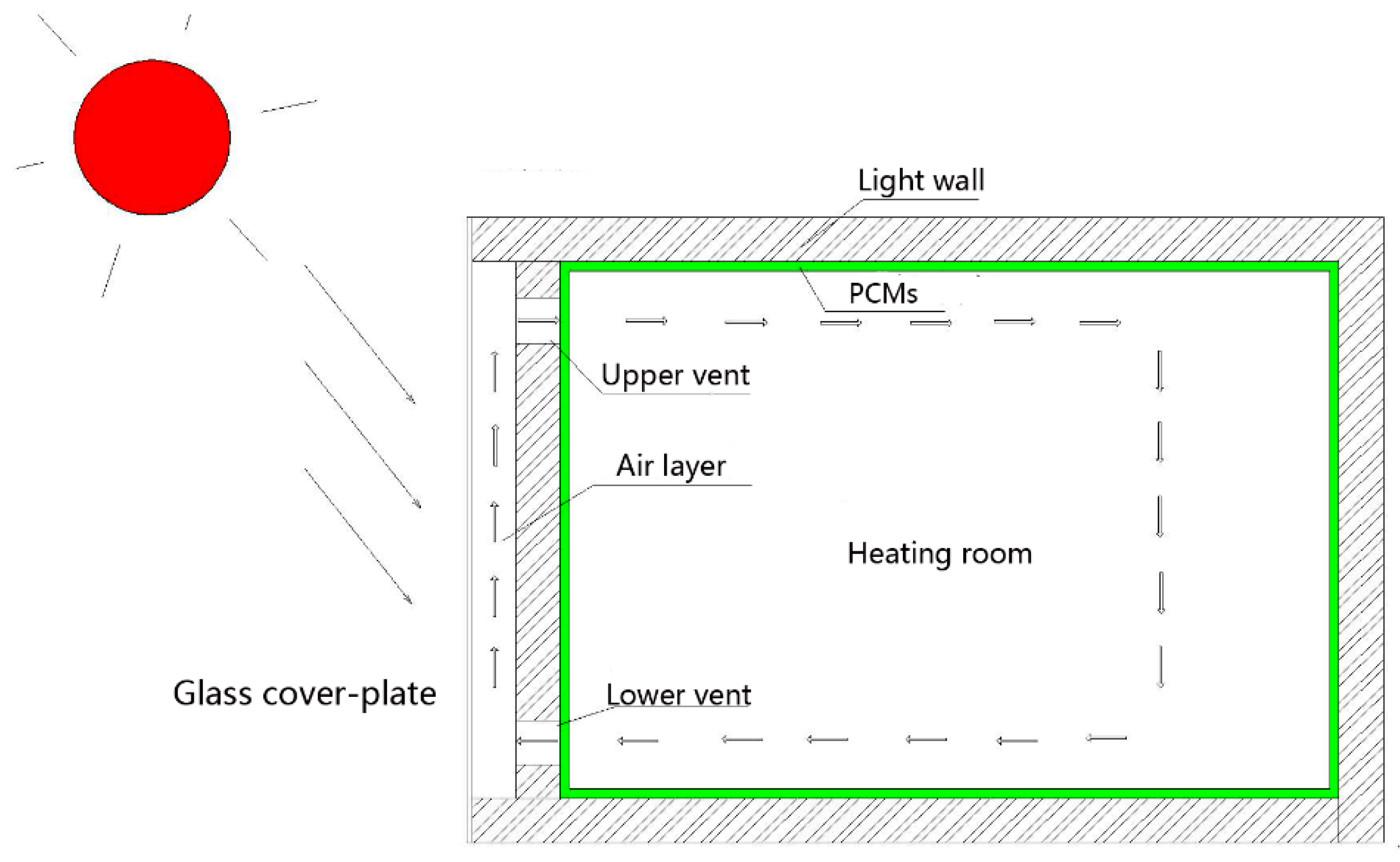
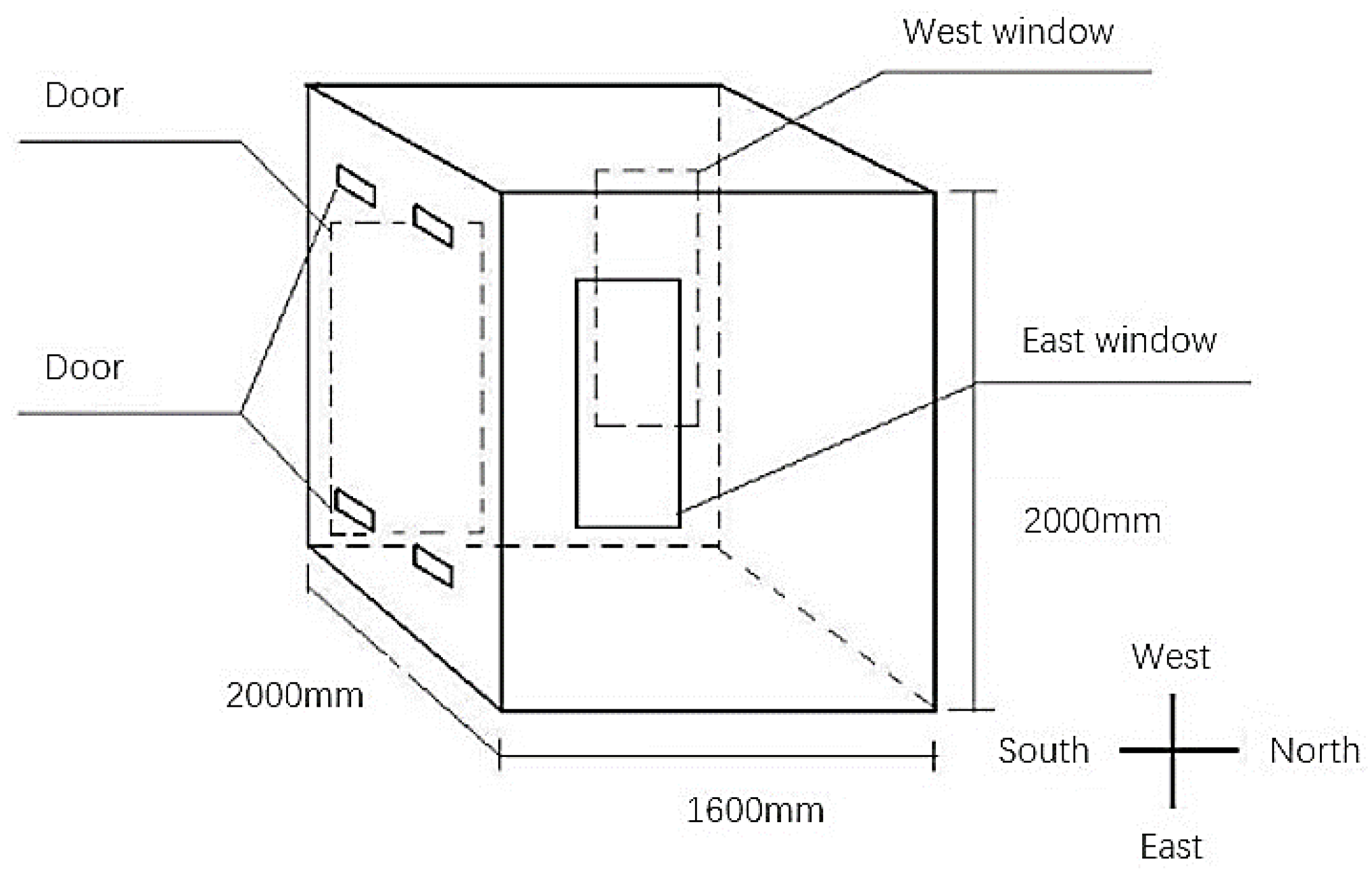
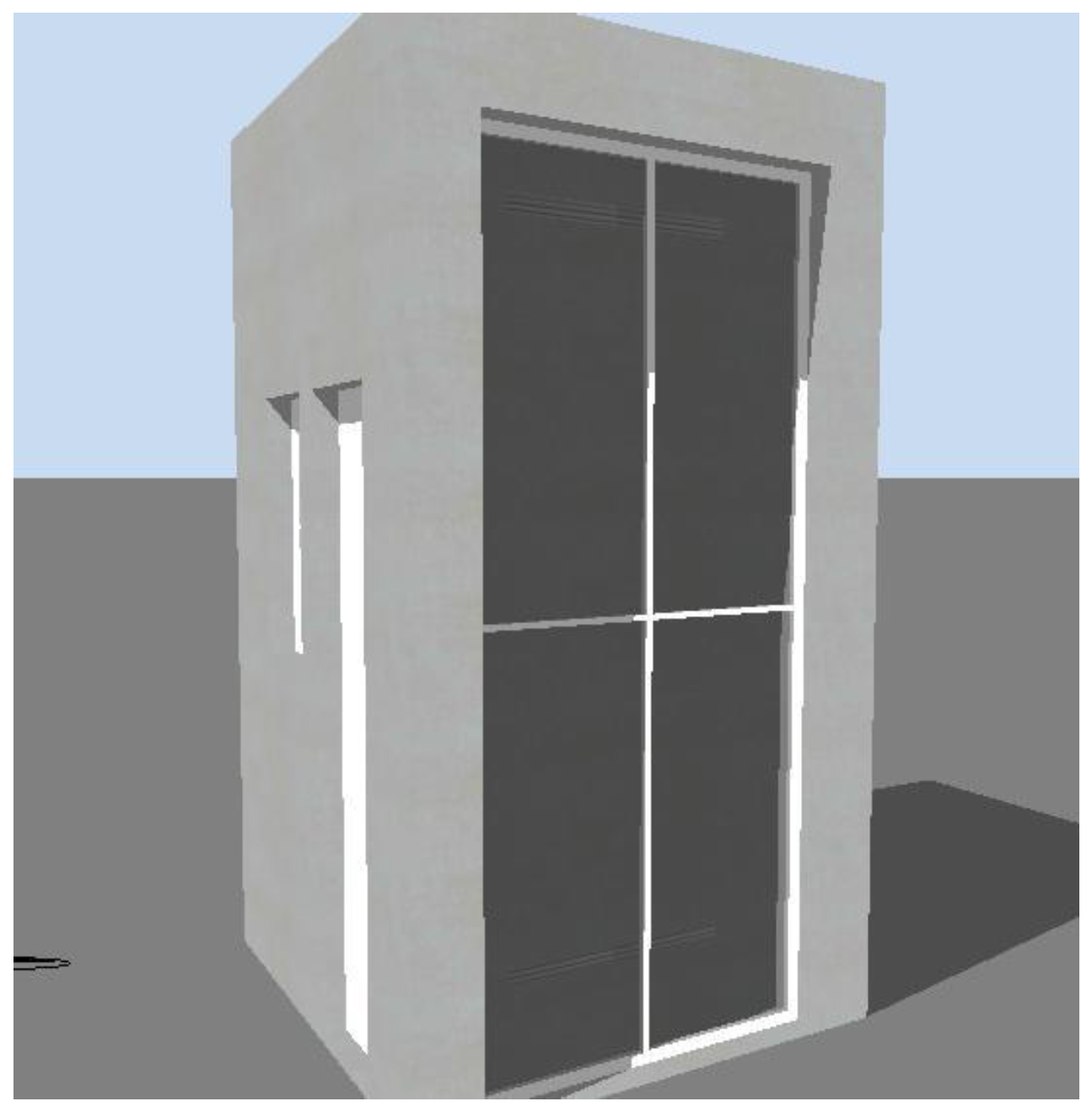

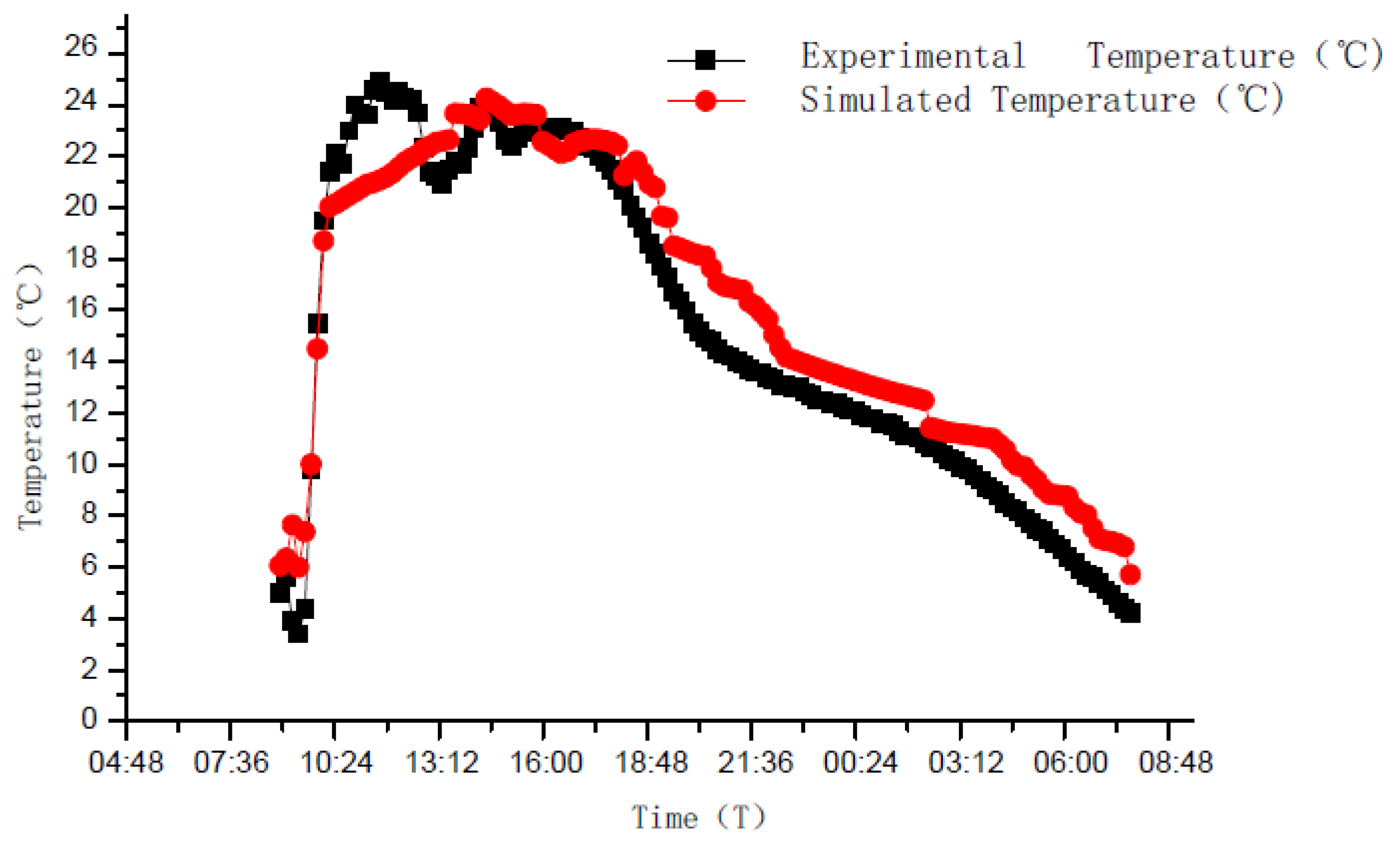
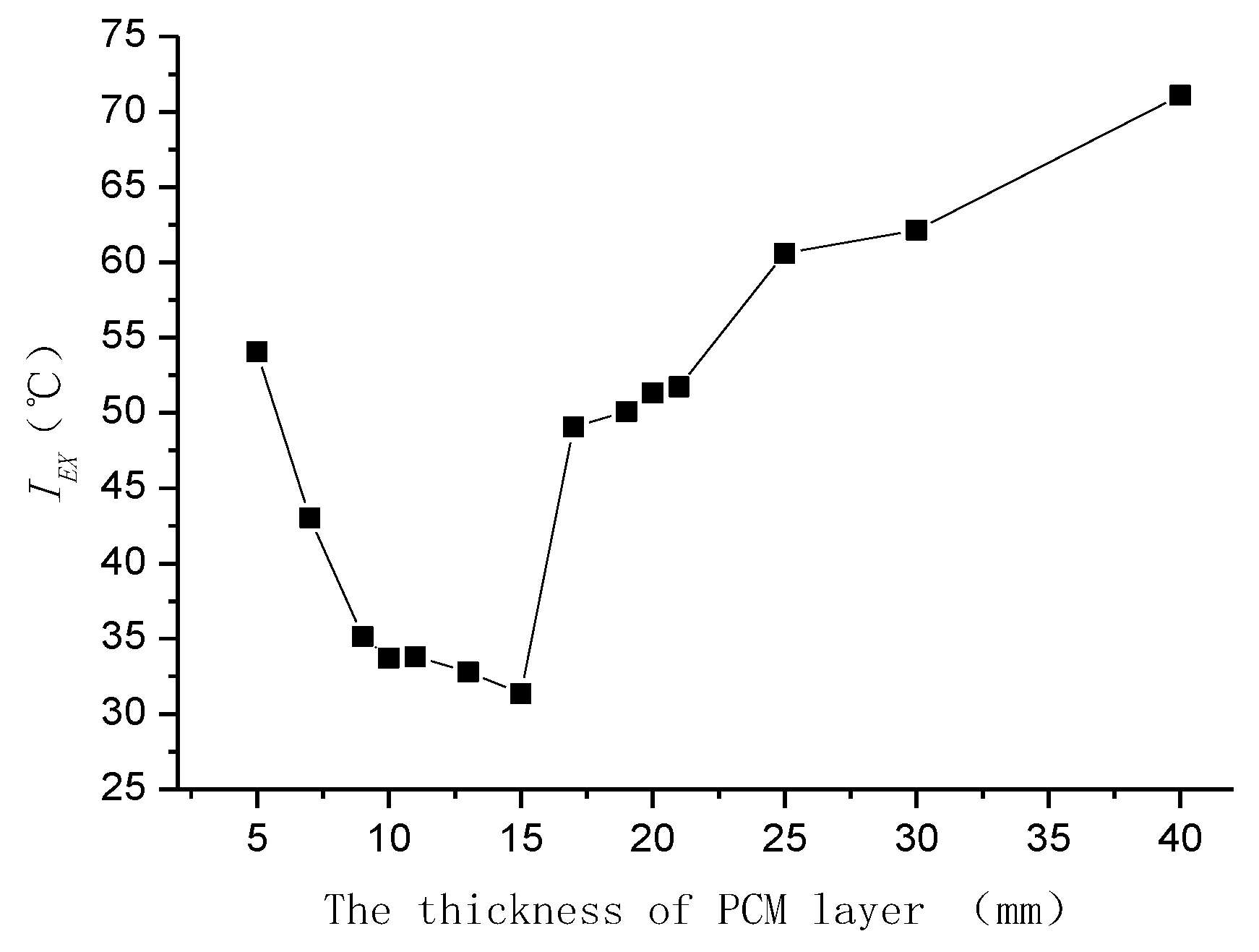
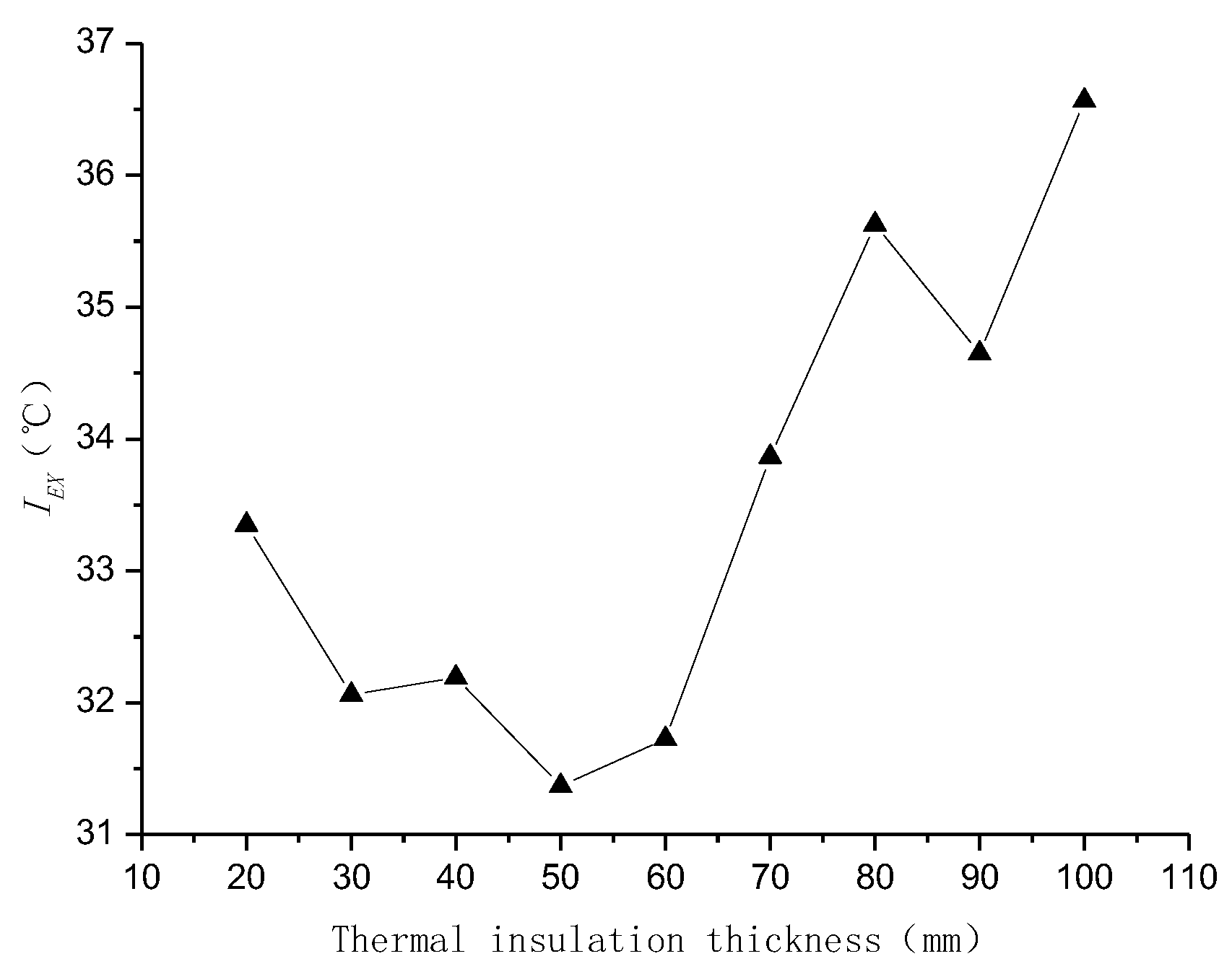
| Number | Conductivity (W/m·K) | Density (kg/m3) | Component Mass (g) | PCT (°C) | ||
|---|---|---|---|---|---|---|
| Capric Acid | Lauric Acid | Myristic Acid | ||||
| 13# | 0.31 | 1050 | 120 | 100 | 45 | 12–13 °C |
| 15# | 0.31 | 1100 | 120 | 100 | 47 | 14–16 °C |
| 20# | 0.33 | 1150 | 120 | 100 | 50 | 19–21 °C |
| 25# | 0.34 | 1100 | 110 | 100 | 50 | 24–26 °C |
| Parameters | Unit | Outer Steel Plate | EPS Plate | PCM | Inner Steel Plate |
|---|---|---|---|---|---|
| Conductivity | w/(m·K) | 49.9 | 0.042 | 0.31 | 49.9 |
| Thickness | mm | 0.5 | 100 | 10 | 0.5 |
| Thermal resistance | m2·K/w | 0.00001 | 2.38 | 0.033 | 0.00001 |
| Heat storage coefficient | w/m2·K | 112.2 | 0.36 | 24.82 | 112.2 |
| Heat inertness index | - | 0.001 | 0.86 | 0.82 | 0.001 |
| Thickness mm | Phase Change Temperature (°C) | ||||||
|---|---|---|---|---|---|---|---|
| 13 | 15 | 17 | 20 | 21 | 23 | 25 | |
| 5 | 54.07 | 53.19 | 54.04 | 53.94 | 53.48 | 54.85 | 53.44 |
| 7 | 43.84 | 45.18 | 43.04 | 44.35 | 44.58 | 43.58 | 43.18 |
| 9 | 37.55 | 36.85 | 35.14 | 36.88 | 34.95 | 36.07 | 35.28 |
| 10 | 34.00 | 34.64 | 33.71 | 33.19 | 35.51 | 33.52 | 35.18 |
| 11 | 34.13 | 34.32 | 33.82 | 33.44 | 34.56 | 34.77 | 32.88 |
| 13 | 32.89 | 32.57 | 32.81 | 34.67 | 32.45 | 32.82 | 34.08 |
| 15 | 34.24 | 31.89 | 31.37 | 34.26 | 34.55 | 34.28 | 34.73 |
| 17 | 52.20 | 52.58 | 49.08 | 53.62 | 52.23 | 51.53 | 51.81 |
| 19 | 52.40 | 52.35 | 50.08 | 52.46 | 50.21 | 51.19 | 50.76 |
| 20 | 53.78 | 53.58 | 51.33 | 51.06 | 50.83 | 53.77 | 53.28 |
| 21 | 52.52 | 52.79 | 51.74 | 54.54 | 52.45 | 51.42 | 52.53 |
| 25 | 61.27 | 61.40 | 60.61 | 61.88 | 61.94 | 61.99 | 61.05 |
| 30 | 62.52 | 63.32 | 62.14 | 62.88 | 64.36 | 62.84 | 62.69 |
| 40 | 73.35 | 74.85 | 71.08 | 71.72 | 71.18 | 70.78 | 68.74 |
| Thermal Insulation Thickness (h, mm) | 20 | 30 | 40 | 50 | 60 | 70 | 80 | 90 | 100 |
|---|---|---|---|---|---|---|---|---|---|
| IEX (°C) | 33.35 | 32.06 | 32.19 | 31.37 | 31.73 | 33.86 | 35.63 | 34.65 | 36.57 |
| |∆IEX/∆h| | 0.034 | 0.04 | 0.03 | 0.01 | 0.07 | 0.05 | 0.03 | 0.05 |
Disclaimer/Publisher’s Note: The statements, opinions and data contained in all publications are solely those of the individual author(s) and contributor(s) and not of MDPI and/or the editor(s). MDPI and/or the editor(s) disclaim responsibility for any injury to people or property resulting from any ideas, methods, instructions or products referred to in the content. |
© 2023 by the authors. Licensee MDPI, Basel, Switzerland. This article is an open access article distributed under the terms and conditions of the Creative Commons Attribution (CC BY) license (https://creativecommons.org/licenses/by/4.0/).
Share and Cite
Cheng, L.; Zhuang, C.; Li, S.; Huang, G.; Zhang, H.; Gan, F.; Xu, N.; Hou, S. Thermal Performance Optimization Simulation Study of a Passive Solar House with a Light Steel Structure and Phase Change Walls. Energies 2023, 16, 3725. https://doi.org/10.3390/en16093725
Cheng L, Zhuang C, Li S, Huang G, Zhang H, Gan F, Xu N, Hou S. Thermal Performance Optimization Simulation Study of a Passive Solar House with a Light Steel Structure and Phase Change Walls. Energies. 2023; 16(9):3725. https://doi.org/10.3390/en16093725
Chicago/Turabian StyleCheng, Lei, Chunlong Zhuang, Shengbo Li, Guangqin Huang, Hongyu Zhang, Fei Gan, Ningge Xu, and Shanshan Hou. 2023. "Thermal Performance Optimization Simulation Study of a Passive Solar House with a Light Steel Structure and Phase Change Walls" Energies 16, no. 9: 3725. https://doi.org/10.3390/en16093725
APA StyleCheng, L., Zhuang, C., Li, S., Huang, G., Zhang, H., Gan, F., Xu, N., & Hou, S. (2023). Thermal Performance Optimization Simulation Study of a Passive Solar House with a Light Steel Structure and Phase Change Walls. Energies, 16(9), 3725. https://doi.org/10.3390/en16093725





